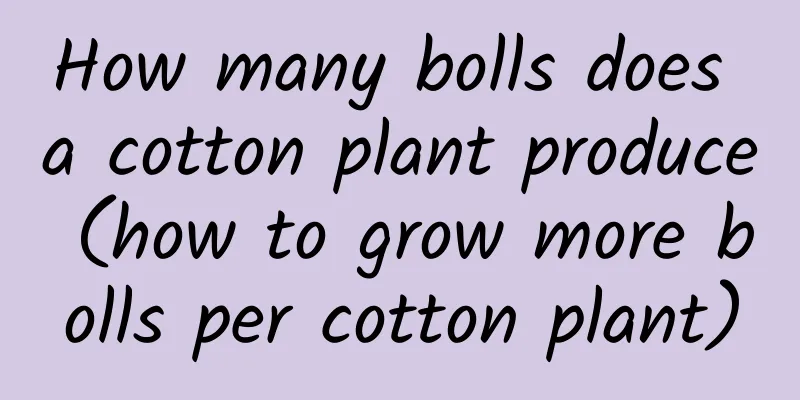How many bolls does a cotton plant produce (how to grow more bolls per cotton plant)

Number of bolls per cotton plantIn layman's terms, it refers to the number of bolls on a cotton plant. The cotton we grow nowadays usually has 7 or 8 bolls per plant. Some have 5 or 6 bolls, and some have 9 or 10 bolls or even more . This is mainly determined by our geographical conditions, cultivation management, etc. We used to be a cotton producing area, almost every household planted cotton, which was the main cash crop at that time. The first stop I started working was the cotton station, where I collected cotton during the day and weighed it at night. It was very tiring. But now there is little cotton planting here. Soybeans and cotton have quietly left and are no longer in everyone's planting list. To grow cotton with high yield, the requirements are: 1. Autumn peaches cover the top and summer peaches are full to the waist, so the racks should be firmly built for high yieldGenerally speaking, the sign of a good cotton harvest is the arrival of the dog days, with the dog days bearing full waists and the autumn days bearing tops. First, bring peaches into the dog days To achieve this, it is necessary to sow or transplant at the right time. The sowing time of cotton varies from place to place. Here we usually sow in the Grain Rain and the seedlings appear in the Beginning of Summer. Pay attention to shortening the seedling acclimatization period to promote early budding, early flowering, and early fruiting. The second is Fu Tao Man Yao In order to achieve full peach trees in summer, it is necessary to steadily apply flower and bell fertilizer, prune branches in time, and prevent diseases and pests scientifically. Finally, the autumn peach covers the top There are "three peaches" of cotton, namely pre-summer peach, summer peach and autumn peach. Among the three peaches, it is particularly important to strive for autumn peach, because autumn peach is at the top of the cotton plant, with good light and ventilation conditions, which is conducive to boll setting and peach setting. In addition, the cotton wool is long and of good color, which is the main indicator of yield formation. Therefore, it is required to top the trees in time so that the three fruit branches on the top can grow early and bear more peaches, and at the same time, fertilizer and water management and pest control work should be strengthened. The following is a brief introduction to the management measures during the seedling stage, bud stage, flower and boll stage, and later stages. Second, planting cotton in the field requires the same management as planting rustThe growing period of cotton is long, and each stage must be carefully managed. Only with great care and meticulousness can a high yield be achieved. Cotton farmers figuratively call it rust flower. 1. Management during the seedling stage The focus of cotton seedling management is to cultivate strong seedlings and roots, lay a good foundation for high yields, prevent vigorous seedlings, barren seedlings, tall seedlings and weak seedlings, and ensure steady growth and early emergence of strong seedlings. I usually spray Tianda 2116 Zhuang Miao Ling 2-3 times during the seedling stage of cotton, which really has a very good effect, showing that the seedlings are strong, uniform, and not too long. I suggest you try it. 2. Bud management The focus of cotton bud management is to coordinate the relationship between nutrition and reproductive growth, build a high-yield framework, and produce more buds. In terms of fertilizer and water management, if there is drought during the flowering or budding period, pay attention to watering, but not too much. For low-yield fields and slow-growing and weak cotton fields, water them early, and apply 20-30 kilograms of urea per mu to promote growth and set up a high-yield framework. For plots with vigorous growth, spray with growth-enhancing agents to control the situation. Pay attention to potassium supplementation for plots lacking potassium. In terms of insect pests, pay attention to the prevention of blind bugs and aphids. 3. Management during the flowering and boll period The management goal of cotton plants during the flowering and boll stage is to promote early boll setting and more boll setting, ensure that the pre-summer peaches are at the bottom, the summer peaches are full to the waist, and the autumn peaches are top covered, prevent excessive growth, late peaches, falling peaches, and rotten peaches. During this period, the main focus is topping to control plant height, which is generally 85-90 cm, with about 10 fruit branches. Pay attention to ventilation and light transmission. The main thing in water and fertilizer management is to water the flowers and bells well to prevent drought. In combination with watering, apply about 20 kilograms of urea per mu, or 10-20 kilograms of diammonium phosphate. The main pests and diseases to be controlled are bollworm, aphids, red spiders, rotten bolls, etc. Pay attention to foliar fertilizers for premature cotton fields, such as urea solution, potassium dihydrogen phosphate, etc. The key point is to top the plants, according to the principle of "different branches at different times and different branches at different times". Here we use "small topping in Lesser Heat and big topping in Greater Heat", with the standard of removing the top core or 1 leaf 1 core or 2 leaves 1 core. 4. Post-management The management of cotton in the later stage is mainly to increase the boll weight, strive to cover the top, prevent premature aging, prevent greed and late maturity, prevent biting, falling, drying and rot, and promote the development of bolls in the middle and upper parts. At this time, attention should be paid to controlling the humidity in the field, preferring dryness to wetness, preventing rotten bolls from falling off, and doing a good job of chemical control and disease and pest prevention. The main focus of disease and pest control is to control autumn aphids, cotton bollworms, boll rot, etc. For premature cotton fields, pay attention to supplementing foliar fertilizers such as urine or potassium dihydrogen phosphate. As the saying goes, "Fight seven, eight, and nine, and attack water, fertilizer, and insects fiercely." July to September is the peak flowering and boll-forming period for cotton, which is a critical period that determines cotton yield and is also the fastest growing period in its life. It has a greater demand for fertilizer and water, and at the same time, the number of diseases and pests is increasing. This is an important period for cotton management, so during these three months, we must pay attention to re-applying flower and boll fertilizers, doing a good job in pest control and drought resistance, ensuring that the fruit branches have more bolls and increasing yields. |
Recommend
How to make orchids sprout more and what fertilizer to use
1. Suitable planting material When cultivating or...
"Experience" Summer Care Methods for Clematis
Clematis long petal evergreen variety Such as: lo...
Can the dripping Guanyin be cultivated hydroponically?
1. Hydroponics The weeping angel can be grown in ...
How to grow hibiscus
1. Breeding environment (1) Soil: The most basic ...
Planting method and adaptation environment of Codonopsis pilosula
Codonopsis pilosula, also known as three-leaf veg...
What fertilizer is best for money bag
Fertilization time of money bag When planting the...
Taboos of breeding winter red in winter
Although winter is the flowering season, do not w...
When is the best time to transplant lemon trees (when should lemon seedlings be repotted)
When transplanting lemon trees, the soil you choo...
The Feng Shui effect of green radish
1. Feng Shui Effect Placing it in the right posit...
How to fertilize rosemary
How to fertilize 1. Rosemary is not a fertilizer-...
The difference between hairy yam and iron stick yam
1. Difference in shape The difference between the...
Do figs like the sun?
Figs like the sun Fig likes the sun and is a sun-...
The most diligent and disease-resistant clematis. Which varieties of clematis bloom the most and are the best to grow?
Clematis is a climbing vine that can climb along ...
How to care for tiger skin plant in winter
1. Cold and heat preservation It is a thermophili...
How to raise a thunder child
1. Breeding environment 1. Soil: Lei Tong does no...









